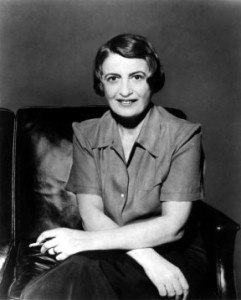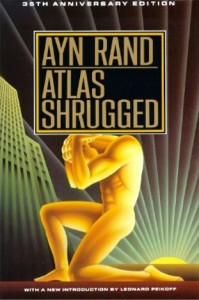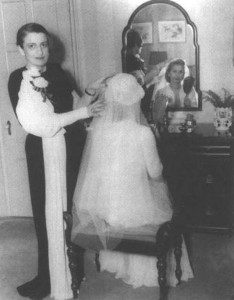So what the heck is the true meaning of Christmas, anyway? Here is what Ayn Rand, perhaps the strangest of modern cult messiahs, had to say:
The best aspect of Christmas is the aspect usually decried by the mystics: the fact that Christmas has been commercialized. The gift-buying . . . stimulates an enormous outpouring of ingenuity in the creation of products devoted to a single purpose: to give men pleasure. And the street decorations put up by department stores and other institutions—the Christmas trees, the winking lights, the glittering colors—provide the city with a spectacular display, which only “commercial greed” could afford to give us.

For a Rand quote, I find that unusually entertaining. But what’s so strange about Rand as a cult leader? We tend to think of cults as being irrational by definition, based on bizarre ideas, unbelievable unless you’re under the spell of a mind-controlling messiah. Rand’s cult is, on the surface, the very antithesis of that: a group based around the idealization of the rational and the objective—hence the name, Objectivism. Rand’s gospel involved, not mystical healings or heaven-sent powers, but individual rights, the moral pursuit of self-interest, and laissez-faire capitalism. So where does the cult aspect come in?
 Ayn Rand was a novelist by trade, but a philosopher by inclination. Many people consider her the most important novelist AND philosopher of the twentieth century. Many do not. She was born Alisa Rosenbaum in Russia in 1905 to a privileged professional Jewish family, somewhat impoverished in 1917 by the revolution. She studied history and philosophy in Petrograd University, but already she was writing; and when she got a visa to visit American relatives in 1925, she stayed on, went to Hollywood, and after some of the usual vissicitudes became a screenwriter and novelist. She also married a minor actor named Frank O’Connor in 1929, a marriage that lasted until his death in 1979. But her writing had a purpose beyond movies, fame or fortune. Her books were intended to be vehicles for her developing philosophy; her characters were idealized people demonstrating how the world according to Ayn Rand should work.
Ayn Rand was a novelist by trade, but a philosopher by inclination. Many people consider her the most important novelist AND philosopher of the twentieth century. Many do not. She was born Alisa Rosenbaum in Russia in 1905 to a privileged professional Jewish family, somewhat impoverished in 1917 by the revolution. She studied history and philosophy in Petrograd University, but already she was writing; and when she got a visa to visit American relatives in 1925, she stayed on, went to Hollywood, and after some of the usual vissicitudes became a screenwriter and novelist. She also married a minor actor named Frank O’Connor in 1929, a marriage that lasted until his death in 1979. But her writing had a purpose beyond movies, fame or fortune. Her books were intended to be vehicles for her developing philosophy; her characters were idealized people demonstrating how the world according to Ayn Rand should work.
And how is that? If you strip off the jargon, her books seem to be saying that humanity divides into heroic individuals, who need to go their own way and do their own thing, viewing their own happiness as the highest moral good; and parasites, who bleat about altruism and collectivism and helping the needy, but are really just trying to leech off the heroic true achievers. The imperative, then, is that one must be rational, must think for oneself, and must be an individual of the fairly rugged persuasion. Which is ironic, given how things turned out.
 The two novels for which she is most famous are The Fountainhead (1943) and Atlas Shrugged (1957). These were her manifestos; and alas, for some us, they suffer as novels from having to bear the heavy burden of her philosophy. Myself, I find them stodgy, stiff, clichéd, and peopled with cardboard characters. The heroes are all big, rich and handsome. The villains are weak, snivelling and small. The women like to be taken by force. The dialogue is as far from natural as it is possible to be—one character, John Galt of Atlas Shrugged, delivers a radio speech that runs for a full chapter (over fifty solid pages), would take three hours to deliver aloud, and plods through, in deadening detail, the philosophy of objectivism. Myself, I’d have dashed that radio against the wall within the first five minutes. And the critics of the time pretty much expressed similar views.
The two novels for which she is most famous are The Fountainhead (1943) and Atlas Shrugged (1957). These were her manifestos; and alas, for some us, they suffer as novels from having to bear the heavy burden of her philosophy. Myself, I find them stodgy, stiff, clichéd, and peopled with cardboard characters. The heroes are all big, rich and handsome. The villains are weak, snivelling and small. The women like to be taken by force. The dialogue is as far from natural as it is possible to be—one character, John Galt of Atlas Shrugged, delivers a radio speech that runs for a full chapter (over fifty solid pages), would take three hours to deliver aloud, and plods through, in deadening detail, the philosophy of objectivism. Myself, I’d have dashed that radio against the wall within the first five minutes. And the critics of the time pretty much expressed similar views.
BUT—some people found Rand’s novels revelatory, literally life-changing. These people tended to be intelligent, young, well educated and upper-middle-class, reading Rand in their teens or early twenties. An admiring group began to gather around her in her New York apartment, hanging on her every word. The Ayn Rand cult was born. Atlas Shrugged became the next thing to a holy text.
It is interesting to see, through the memoirs of various participants in Rand’s circle, how a literary discussion group can morph into a personality cult. The venerated leader is empowered to lay down the law to her followers—what they must think, which works of art are correct for them to appreciate, whom they may form sexual relationships with, and so forth. Her every word must be considered capital-T Truth, to be internalized without question or debate. A hierarchy develops, with an inner circle laying down the law to the rest in the leader’s name, and exerting psychological and even physical pressure to keep lower members in line.
All those steps were taken in short order by Rand’s circle, and became more marked as her circle grew into an organization. Harsh criticism and agonized self-criticism were common, with distinctly Orwellian overtones. The ultimate penalty, though, was excommunication, after which the excommunicated individual was to be considered dead, in a way reminiscent of, say, Scientology or the Latter Day Saints. A large number of young people came out of the Ayn Rand experience bitter and damaged.
Ayn’s personality also emerges clearly in memoirs of people who passed through her cult. Autocratic, egoistic, jealous, demanding of attention, prone to terrible rages if crossed; but also highly intelligent, stimulating, charismatic, addictive. Getting Rand’s nod of approval became an obsession among her followers; losing her favour became their worst fear. This is the great irony: to gain her approval, they were required to stop thinking for themselves—in the service of a philosophy that prized heroic individualism, they had to turn themselves into clones. And by all accounts, they had to spend so much time worrying about getting things right, and casting out wrong thinking, that there was little opportunity to pursue happiness, productive achievement, or rationality. It sounds like a particularly earnest, anxious and joyless cult.
 Now the dirt—the gossipy bit. Though it’s illuminating gossip, so it’s in for a reason. The original inner circle consisted largely of Canadians, oddly enough, some of them related to each other. At the top, the brightest and best, the designated successor, was a lad from Winnipeg, Nathaniel Branden, and his girlfriend Barbara Weidman, who first came under Ayn’s influence when they were 19 years old. As the group evolved into a large, complex organization, Nathaniel was given the running of it, and was even allowed to coauthor papers with Rand. He began to show signs of autocratic messianism himself. When, with Ayn’s blessing, Nathaniel married Barbara, Ayn was the bridesmaid, and her husband Frank the best man. Rand considered Branden the incarnation of her idealized heroes.
Now the dirt—the gossipy bit. Though it’s illuminating gossip, so it’s in for a reason. The original inner circle consisted largely of Canadians, oddly enough, some of them related to each other. At the top, the brightest and best, the designated successor, was a lad from Winnipeg, Nathaniel Branden, and his girlfriend Barbara Weidman, who first came under Ayn’s influence when they were 19 years old. As the group evolved into a large, complex organization, Nathaniel was given the running of it, and was even allowed to coauthor papers with Rand. He began to show signs of autocratic messianism himself. When, with Ayn’s blessing, Nathaniel married Barbara, Ayn was the bridesmaid, and her husband Frank the best man. Rand considered Branden the incarnation of her idealized heroes.
So it’s maybe not surprising that we come to another common messianic characteristic, one that crops up repeatedly: a sense of sexual entitlement. Though Rand was twenty-five years older than Branden, she thought it was natural that they, the two preeminent thinkers of the twentieth century, should get together. Branden agreed. Their spouses put up with it, because that’s what you have to do when you’re married to junior and senior messiahs. The sexual arrangement lasted only a couple of years, but Rand later wished to resume relations. Branden put her off with various excuses until 1968, when Rand discovered he was having a secret affair with the young and beautiful woman who later became his second wife; all hell broke loose.
Rand was enraged. Obviously Branden was not a real objectivist, and obviously he was not worthy of her trust. He was excommunicated, excised from the group, turned into a nonperson. Rand never forgave him. It was not, of course, the end of Branden; he is still around, now in his eighties, the messiah of his own little self-help movement. (Barbara Branden, another major player in the drama, died only yesterday.) Nor, of course, was it the end of Rand’s cult. Her books are still bestsellers, and her organization is still with us in the form of the Ayn Rand Institute, her lasting effect on the libertarian movement and, heaven help us, her disciple Alan Greenspan, whose efforts to run the Fed by Randian principles did not have perhaps the happiest of outcomes. Perhaps it is dangerous in general to turn a messianic theory into actual practice.
One final word on Rand, an interesting link with the messianic pattern. In her own special way, she had a millenarian, apocalyptic agenda. In Atlas Shrugged, Rand’s heroes, the productive laissez-faire capitalists, get tired of being exploited by the parasites, and go on strike. That is, they go into hiding in a little enclave in the mountains, where they can all be happy laissez-faire capitalists together—meantime the outside world, deprived of their creative and heroic influence, slides into chaos and Armageddon. That message became stronger and stronger as Rand aged: the urgent message that her philosophy of objectivism was the world’s only hope of salvation, the only way that twentieth-century messianic woes could be followed by a shining objectivist utopia.
Note: with help from the Tea Party and affiliates, Atlas Shrugged is being turned into a monumentally dreadful trilogy of movies. Alas, it appears that plans to shoot Part 3 as a musical were abandoned. The charming Christmas tree ornaments shown at the top of this post are available from the movie’s website.

